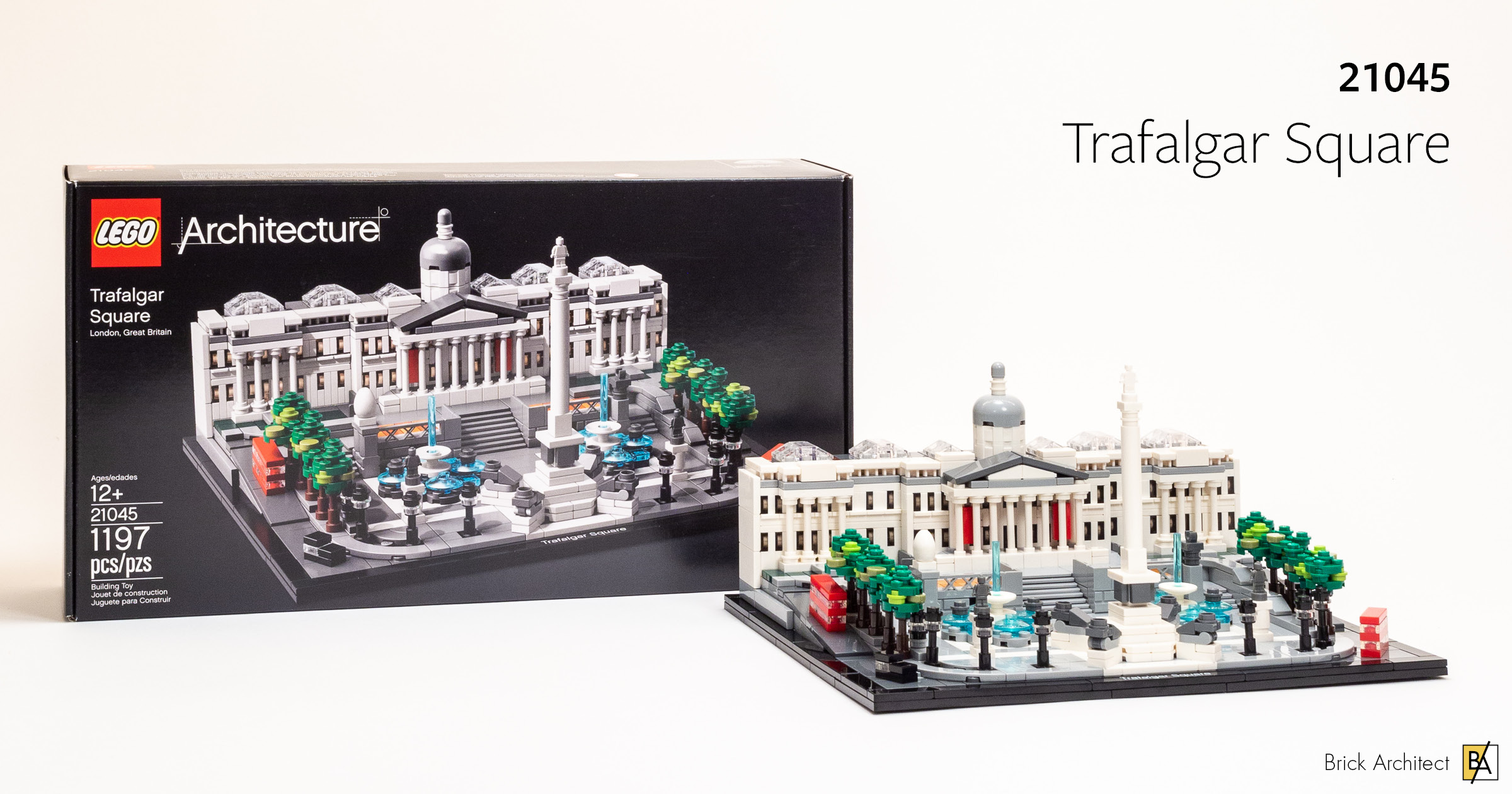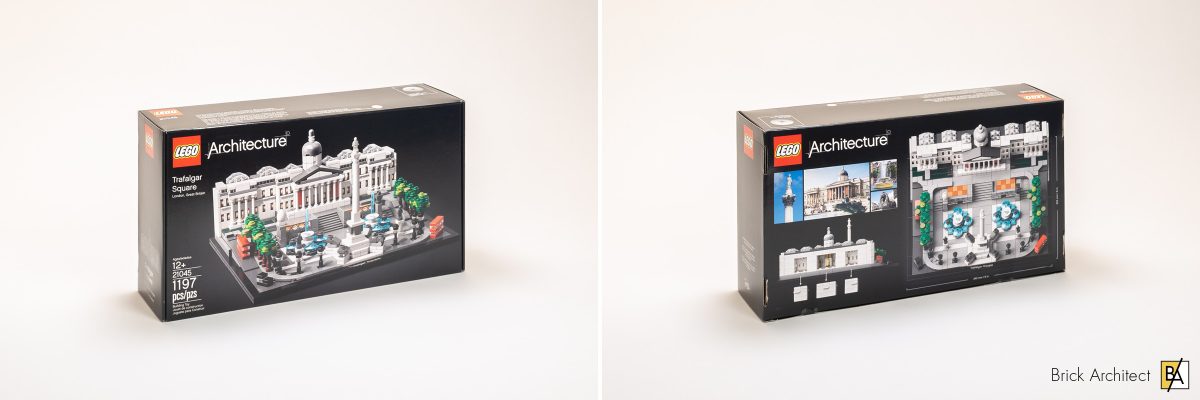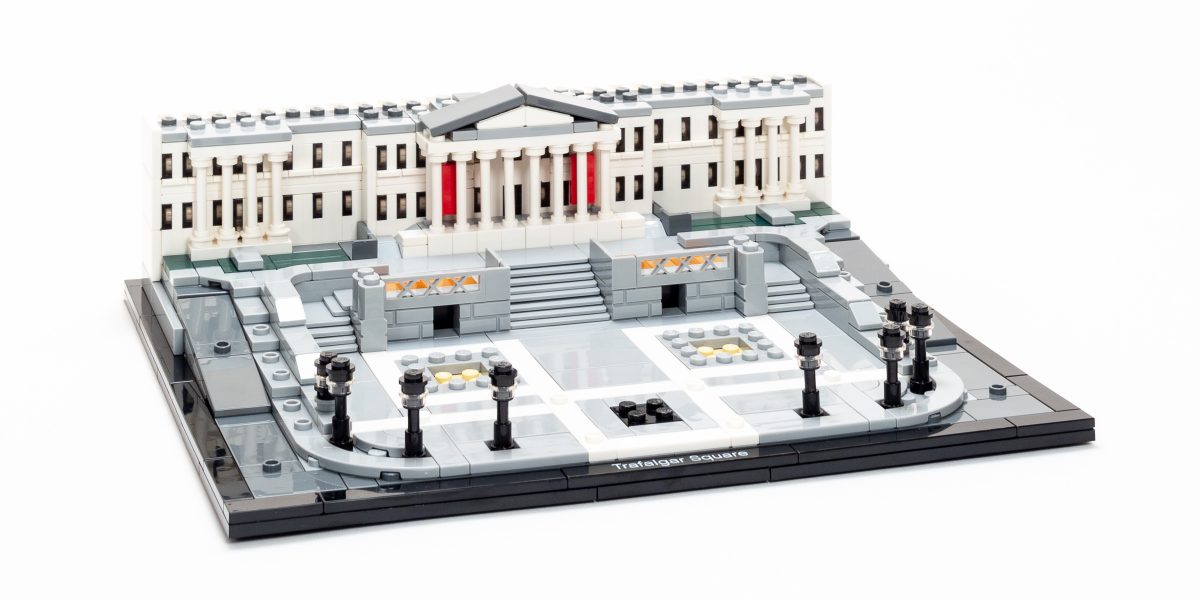Review: #21045 Trafalgar Square
Does a set containing an entire plaza belong in the LEGO Architecture series? Lord Business says yes (since there’s a LEGO Store nearby), but I’m not sure…
I want to say that I was excited to learn that Trafalgar Square was being added to the LEGO Architecture series, but I’m afraid my initial impression was pretty negative. It felt like they hid the primary architectural elements behind statues and trees!
While Nelson’s column (and the four lions surrounding it) is a pretty famous landmark, the National Gallery behind it is less iconic and it is not an particularly celebrated example of Neoclassical architecture.
To be fair, there were a few things that I was excited to see, or at least try… For one, this is the first official set to use an obscure AFOL trick using carefully stacked panels to achieve tiny steps that are just ½ as thick as a standard plate. I was also cautiously optimistic to see if the addition of some topography in the form of ramps leading up to the building would add or detract to the architecture itself.
About the set
#21045 Trafalgar Square:
- Date released: April 27, 2019 (London Flagship Store), August 2019 (Worldwide)
- Price: $79.99 (£79.99, €79.99)
- Piece count: 1197
- Price-per-piece: $0.07
Build Process
The set includes four stages, with multiple numbered bags for each stage of the building process. This is typical for larger sets—it helps you find the parts more quickly since at the beginning of each stage you have fewer than 300 loose parts on the table.

Numbered bags make it easier to assemble the model in four stages.
Bag 1
It’s hard to tell, but the two bags marked for stage 1 look bigger than the other three. As anyone who has built sets in the LEGO Architecture series already knows, we begin by assembling a sturdy base with the familiar black tile border and nameplate.

Completed base at the end of stage 1.
The similarity to previous sets ends here, as this is one of the most complex bases I’ve ever seen. It includes intentional holes, mounting points for hinged elements, and exposed smooth elements at the lowest level of the structure. We also see some SNOT elements that suggest elements which will extend over the 1-stud border. I wouldn’t say that the building the base was especially interesting, but I am intrigued to see how these unusual voids and attachment points will be leveraged later.

The base is quite complicated, with several clips and outward facing studs.
Bag 1, 25 minutes.
Bag 2
The second stage of the build jumps right into an advanced building technique that I was excited to see for the first time in an official LEGO set. We build ½ plate tall steps by carefully stacking 1×2 panels placed on there sides. This results in a no-stud connection, locked in place by the topmost panel.

The ½ plate tall stairs are created using panels placed on their sides and locked into place using SNOT techniques.
This stage goes on to include more of the building interior than I would have expected, including several pieces of “art” (printed tiles) attached to the walls. We wrap up this stage by adding additional tile details to the exterior landscaping and grounds, including a time consuming grid of 1×1 tiles in alternating 38Dark Orange and 312Medium NougatMedium Dark Flesh.
Aligning all of the precise parts, and carefully stacking pieces resulted in a longer build time for this stage than I would have expected.
Bag 2, 35 Minutes.
Bag 3
I was eager to start this stage of the model, as we finally get to build some architecture. I was pleasantly surprised by the complex building techniques that are employed in this stage.
The columns are similar to what we saw in the Lincoln Memorial set, and we wrap up this stage by creating removeable panels to cover the back of the model, while allowing you easily reveal the art gallery hidden within at any time. We also see some interesting techniques to achieve the angled roof above the pediment, which uses technic elements to allow an arbitrary angle.
Bag 3, 40 minutes.
Bag 4
Having nearly completed the “architectural” aspects of the build, I hoped that the last bag would quickly add the finishing touches to the roof and finish the project. There was a bit more to the architectural aspects than I had expected, including a nicely detailed cornice below the roofline created using 1×1 clips. This is a nice detail, similar to how 1×1 round plates were used in #21022 Lincoln Memorial, or the bottom of 1×2 hinges were used on the #21036 Arc de Triomphe.
The roof is completed by the addition of six skylights, and a tall domed roof in the center, which cleverly utilizes Technic elements to achieve an arbirtary angle.
After completing the building, we build two fountains using some clever techniques, and Nelson’s Column which is saved for the very last step. Unfortunately, we also have to spend far too much time for my taste assembling two rows of tiny trees. I strongly believe that half as many trees would have captured the feel of Trafalgar Square, while blocking less of the architectural details. Nonetheless, the finished model looks a bit better than I had expected, largely due to my ability to move around the model to see various details which are blocked when viewing a static photo of the completed set.
Bag 4, 45 minutes.
Conclusion
Here at Brick Architect we take pride in writing honest, and when necessary, critical reviews of LEGO sets. That’s because there are a ton of new sets every year, and we want to help you decide which ones to add to your collection.
I worried that this set would earn a 2/5 star rating due to the overly complex composition and lack of focus on the actual architecture. While I do not love the completed model, it exposes LEGO fans to many creative building techniques that we have never seen in an official LEGO set. This earned my respect, and allows me to give an enthusiastic “Good” (3/5 star) rating to a set that I don’t actually like all that much.
One other great thing for LEGO Artists is that the set is well priced and includes interesting parts, so there’s no shame in taking it apart when you’re done building it to build something new.
About 2 ½ hour build time.











As a London fan in general, I loved building this set and I’m happy to display it next to my London skyline, Buckingham Palace, London bus(ses), etc. I liked the build and I really enjoy the foliage to break up what are usually pretty tan / gray sets.
Interesting thoughts, I agree there is too much foliage and if I have a gripe it’s about the lions. Not that the originals are very accurate either. I modified mine to remove some greenery and the block posts at the front by using some spares grey tiles in there place. My grand daughter loves peaking inside to look at the pictures… She’s just 7 and asked for a Lego architecture set for her birthday so she’s being given London Skyline as her father was born in Greater London…
I guess Lego Architecture must be torn between interesting structures that are architectural classics, and tourist attractions that will shift boxes. Obviously as a business they must shift boxes, but Trafalgar Square is not famous for cutting edge architecture, and never was.